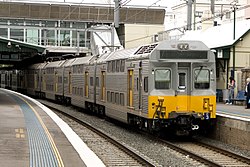
In rail transport, the expression power car may refer to either of two distinct types of rail vehicle:
Contents
- a vehicle that propels, and commonly also controls, a passenger train, potentially a multiple unit train, often as the lead vehicle; [1] [2] [3]
- a vehicle equipped with machinery for supplying heat or electrical power to other parts of a train. [2] [3]
The first of these types of vehicle is closely related to the locomotive. What differentiates the locomotive and the first type of power car is their construction or use. A locomotive can be physically separated from its train and does nothing but provide propulsion and control (and heat or electricity for passenger trains). On the other hand, a power car of the first type is frequently an integral part of its train, and if the train uses distributed traction, some of the car's interior space may be used for carrying passengers or cargo.

